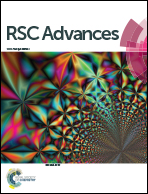First-principle study for influence of an external electric field on the electronic structure and optical properties of TiO2
Abstract
The influence of external electric fields on the electronic structure and optical properties of TiO2 was studied using first-principle calculations. The results showed that the TiO2 energy gap became gradually narrower as the electric field was increased, and it decreased to 0 eV when the electric field was 0.25 eV. All peaks in the density of states gradually broadened, and extended towards low energy with increasing electric field, and overall the peaks of the density of states were split, and the split became larger. The lattice parameter c increased, whereas a and b decreased with increased electric field in the z direction. At the same time, the bond lengths of Ti–O in the z direction increased, whereas those in other directions decreased. The charges mainly transfer from the O 2p orbital to the Ti 3d orbital under an electric field. The dielectric constant, conductivity, refractive index and extinction coefficient of TiO2 with a 0.15 eV electric field were larger than those of TiO2 without an electric field. The absorption edges extended to the visible region, and the absorption in the visible range intensified greatly under the effect of an external electric field, which would enhance the photocatalytic activity of TiO2 and solar energy utilization.


 Please wait while we load your content...
Please wait while we load your content...